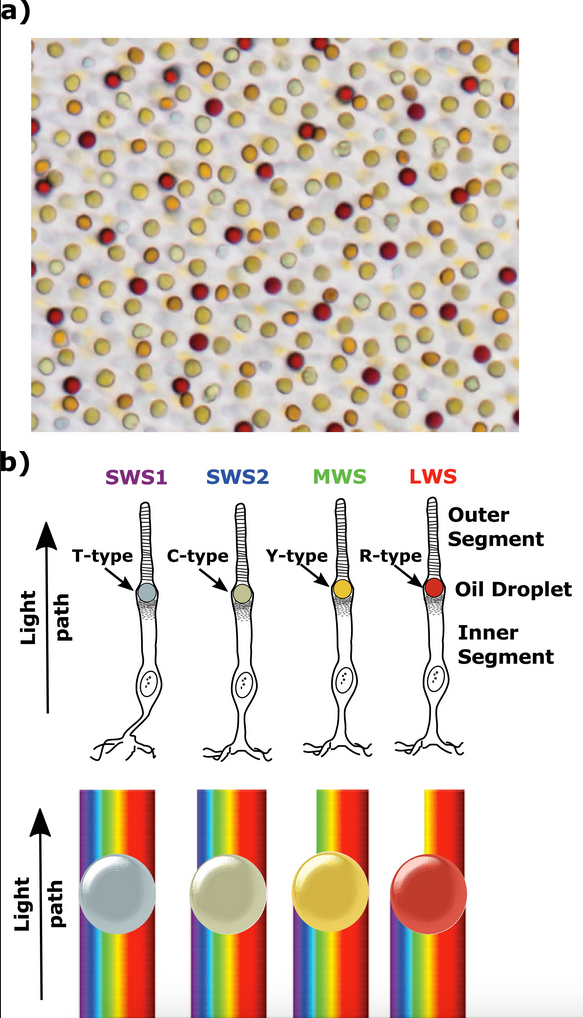How birds unlock their ultraviolet vision super-sense
July 12, 2016
Some birds have been found to be as intelligent as mammals. And some that can see ultraviolet (UV) light live in a super-sensory world apart, able to transmit and receive signals between each other in a way that is invisible to many other species.
Now the ability of finches, sparrows, and many other birds to see ultraviolet (UV) light is explained in a study published in the journal eLife by scientists at the Washington University School of Medicine in St. Louis.
Carotenoid pigments determine bird’s UV perception or not
The study reveals two essential adaptions that enable birds to expand their vision into the UV range: chemical changes in light-filtering pigments called carotenoids (such as carotene, found in carrots, associated with vitamin A) and the tuning of light-sensitive proteins called opsins (light-sensitive proteins), some of which are also used in optogenetics research.
Birds acquire carotenoids through their diets and process them in a variety of ways to shift their light absorption toward longer (visible light) or shorter (UV) wavelengths.
“There are two types of light-sensitive cells, called photoreceptors, in the eye: rods and cones. Cone photoreceptors are responsible for color vision. While humans have blue, green, and red-sensitive cones only, birds have a fourth cone type which is either violet or UV-sensitive, depending on the species,” says senior author Joseph Corbo, MD, PhD, Associate Professor of Pathology and Immunology.
UV vs visual perception by cones in the eye is fine-tuned by evolution
“Our approach showed that blue-cone sensitivity is fine-tuned through a change in the chemical structure of carotenoid pigments within the photoreceptor, allowing both violet and UV-sighted birds to maximize how many colors they can see.”
The study also revealed that sensitivity of the violet/UV cone and the blue cone in birds must move in sync to allow for optimum vision. Among bird species, there is a strong relationship between the light sensitivity of opsins within the violet/UV cone and mechanisms within the blue cone, which coordinate to ensure even UV vision.
Taken together, these results suggest that both blue and violet cone cells have adapted during evolution to enhance color vision in birds.
Birds have achieved UV vision by use of a specialized optical organelle, the pigmented cone oil droplet. These oil droplets are located in the path of light through the receptor and act as cutoff filters matched to the visual pigment sensitivity of each cone subtype.

Spectral filtering in bird cones. a) A flat-mounted chicken retina under brightfield illumination that shows the distinctive pigmentation of the cone oil droplets. (b) A diagram of the avian single cone photoreceptors showing the relative position of the oil droplet within the cells (top) and a representation of the spectral filtering cutoff effects of the droplet (bottom). (credit: Matthew B Toomey et al./eLife)
“The majority of bird species rely on vision as their primary sense, and color discrimination plays a crucial role in their essential behaviors, such as choosing mates and foraging for food. This explains why birds have evolved one of the most richly endowed color vision systems among vertebrates,” says first author Matthew Toomey, a postdoctoral fellow at the Washington University School of Medicine.
“The precise coordination of sensitivity and filtering in the visual system may, for example, help female birds discriminate very fine differences in the elaborate coloration of their suitors and choose the fittest mates. This refinement of visual sensitivity could also facilitate the search for hidden seeds, fruits, and other food items in the environment.”
The team now plans to investigate the underlying molecular mechanisms that help modify the carotenoid pigments and light-sensitive protein tuning in a wide range of bird species, to gather further insights into the evolution of UV vision.
Abstract of Complementary shifts in photoreceptor spectral tuning unlock the full adaptive potential of ultraviolet vision in birds
Color vision in birds is mediated by four types of cone photoreceptors whose maximal sensitivities (λmax) are evenly spaced across the light spectrum. In the course of avian evolution, the λmax of the most shortwave-sensitive cone, SWS1, has switched between violet (λmax > 400 nm) and ultraviolet (λmax < 380 nm) multiple times. This shift of the SWS1 opsin is accompanied by a corresponding short-wavelength shift in the spectrally adjacent SWS2 cone. Here, we show that SWS2 cone spectral tuning is mediated by modulating the ratio of two apocarotenoids, galloxanthin and 11’,12’-dihydrogalloxanthin, which act as intracellular spectral filters in this cell type. We propose an enzymatic pathway that mediates the differential production of these apocarotenoids in the avian retina, and we use color vision modeling to demonstrate how correlated evolution of spectral tuning is necessary to achieve even sampling of the light spectrum and thereby maintain near-optimal color discrimination.